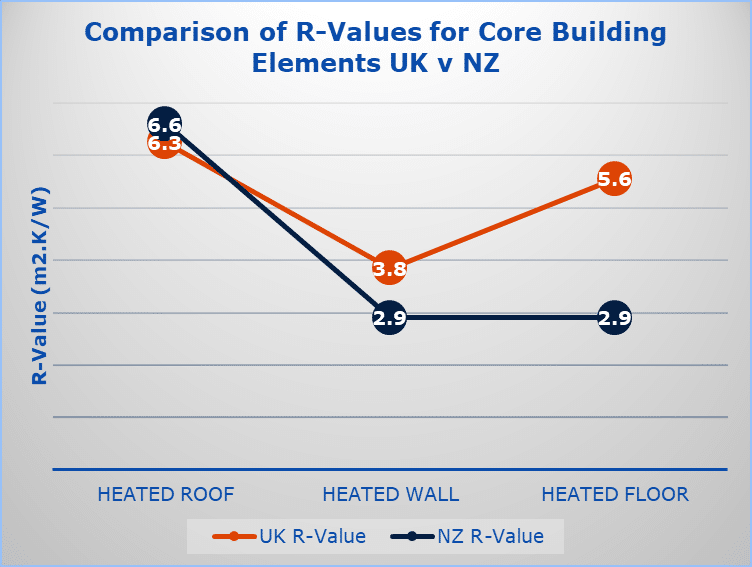New Zealand recently announced a requirement for energy efficiency ratings for all commercial buildings from 2024, echoing similar moves in the UK over 15 years ago. Ollie Cottam considers what the future holds for building energy efficiency standards in New Zealand, and what’s holding us back from a more sustainable built environment.
I began my career as a fresh-out-of-university graduate building surveyor in 2007, in Manchester UK. Shortly after I started, the UK government introduced Energy Performance Certificates (EPCs): first to residential and then to commercial properties. The EPC looks at a building’s energy efficiency – how much energy it uses and how well it conserves it – considering the age and type of heating systems, type of fuel, power loads, building fabric type, amount of insulation, etc.
So in December 2022, when the New Zealand government announced the intention to require energy performance ratings on commercial, public, industrial and large multi-level apartments buildings from 2024 (along with waste reduction from construction activities), I was hit with a sense of déjà vu.
The UK Model: from disclosing EPCs to mandatory MEES
In the UK, for the first 10 years or so an EPC was only required when a property was bought or sold. Then in 2018 the Energy Act came along with its Minimum Energy Efficiency Standards (MEES) which imposed minimum EPC ratings on properties.
EPCs rate buildings on a scale of A to G, A being highest. Currently the minimum standard is an EPC rating of E, however this will be raised to C by 2025, and potentially B by 2030. These minimum standards have pushed the importance of the EPC higher and higher up the property market’s priority list.
Nowadays, having a current and up-to-date EPC is an essential part of the due diligence process when buying or selling a commercial property, and working with consultants with the expertise to interpret and advise upon them is vital.
NZ is starting from a different baseline of building energy performance
New Zealand benefits from a positive “green” image globally. But according to climateactiontracker.org the UK is rated as “Almost Sufficient” in their progress against the Paris Climate Agreement, whereas New Zealand is considered “Highly Insufficient”.
United Kingdom progress against Paris Climate Agreement target to limit global warming to 1.5°C by 2050 as at 17th October 2022:

https://climateactiontracker.org/countries/uk/
New Zealand progress against Paris Climate Agreement target to limit global warming to 1.5°C by 2050 as at 17th October 2022:

https://climateactiontracker.org/countries/new-zealand/
While real estate forms only a fraction of a country’s “green” performance, the typical historic form of construction in New Zealand is not supportive of energy conservation. This applies to both residential and commercial property.
It’s surprising then that the NZ government’s recent announcement did not go further. The obvious step would be a minimum building energy performance rating to encourage property owners to improve their building’s energy ratings, reduce energy consumption and emissions, and lower utilities costs.
Why has the building energy rating legislation not gone further?
Cost is a significant barrier. In March 2022, Savills estimated that only 10% of UK offices have EPC ratings of A and B, and that it would cost £63billion / NZ$126billion to raise the remainder to a minimum of B – all to be financed within the next eight years.
I oversaw a number of projects in England where we spent multi-millions of pounds improving buildings from E to B EPC ratings. These buildings already had the benefit of insulated cavity walls, insulated roofs and double-glazed windows – things that are far from the norm in all but the most modern NZ buildings.
A significant challenge for New Zealand will be that the starting point for the building stock is lower than the UK. What’s more, I suspect the national and global economic situation will also have had an impact on the government’s decision. They will not want to impose additional spending on businesses at a time when the cost of borrowing, materials and labour is already high.
The existing New Zealand building stock, in particular housing, is of poor quality with damp and mould prevalent, making it more costly to make the necessary energy performance gains. Currently priorities for construction projects appear to lie away from sustainability, and instead towards investment benefits, or insured event remedial works from earthquake and flood. There would be a benefit – and probably a need – to encourage tackling energy efficiency at the same time as other works.
Another reason for delaying the introduction of building performance standards is that any new legislation needs to be supported by the existing legislation. A brief comparison with the equivalent UK standards (below) indicates a higher standard of insulation values in the UK legislation.

Are minimum energy standards for buildings coming to NZ anytime soon?
The NZ government’s requirement for a minimum 4-star NABERSNZ rating for buildings occupied by government agencies adds to the value of qualifying buildings. And there are other private occupiers with similar requirements.
The prevalence of other ESG certifications such as Greenstar, added to high NABERSNZ performance, is encouraging as developers recognise the value of better performing buildings. The advantage of improving the energy performance of properties is that it has a direct and calculable payback through reduced energy usage costs. At a time when energy prices are high, there is significant incentive to increase energy efficiency.
The timeline for when minimum standards may be introduced to New Zealand is unclear. The UK’s example of 10 years seems likely (especially with an election this year) given the time it will take to introduce legislation and move to more secure economic footings.
However, the performance of New Zealand against the Paris Climate Agreement will come under more scrutiny. There is a requirement to reduce gross emissions by 44% by 2030 followed by a legal aim for net zero emissions in 2050.
We can help you realise the many benefits of more sustainable buildings
Prendos is passionate about creating a sustainable built environment, through our market leading design and the high quality ESG advice we provide our clients. We can guide you through the process of purchasing or maintaining existing buildings to maximise the benefits of energy efficiency and sustainability.
How to make buildings more sustainable
- Improving insulating performance of the building envelope with roof insulation, wall insulation, double and triple glazed windows.
- Use of Building Management Systems to control natural and mechanical ventilation, heating and cooling.
- Installing renewable energy sources such as solar panels and wind turbines.
- Installing modern, efficient heating and cooling technologies.
- Removing carbon-fuelled systems (e.g. gas) and sourcing electricity from zero carbon suppliers.
- Re-using fit-outs and materials, and repurposing existing buildings.
Ollie Cottam is a commercial building surveyor located in our Auckland office. Ollie moved to Aotearoa New Zealand in August 2022, having spent 15 years working in Manchester, UK, the latest nine years of which were spent with CBRE. Ollie has a personal and professional interest in sustainable real estate, and advises his clients on purchasing and maintaining sustainable buildings.

